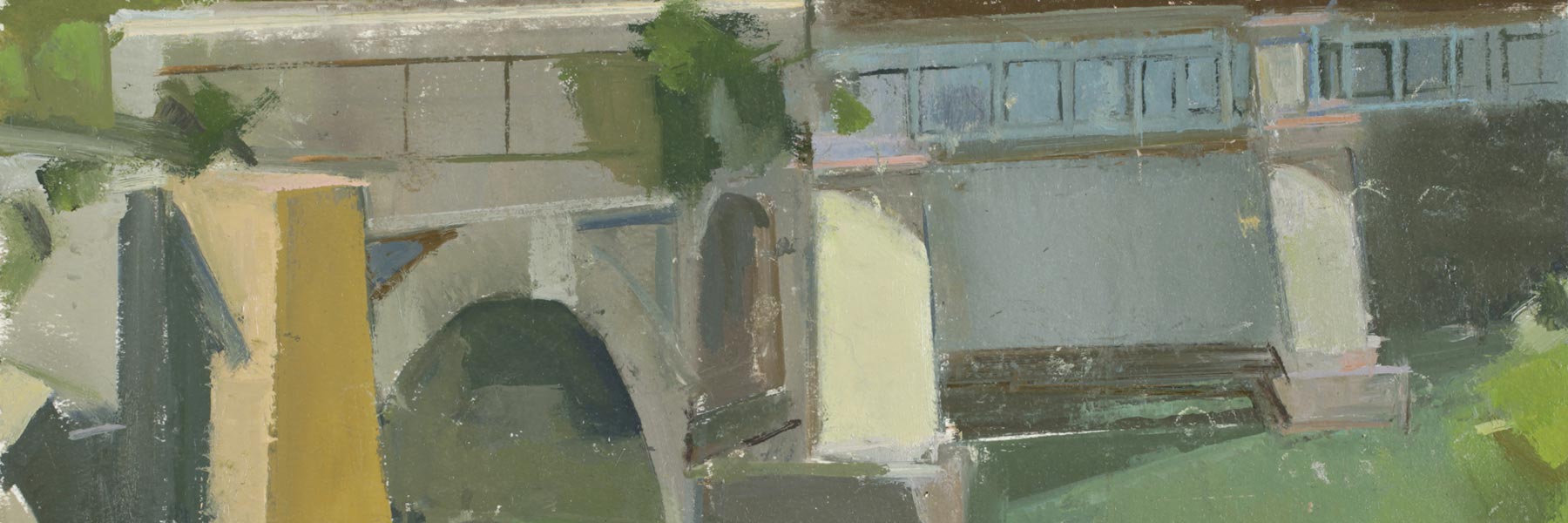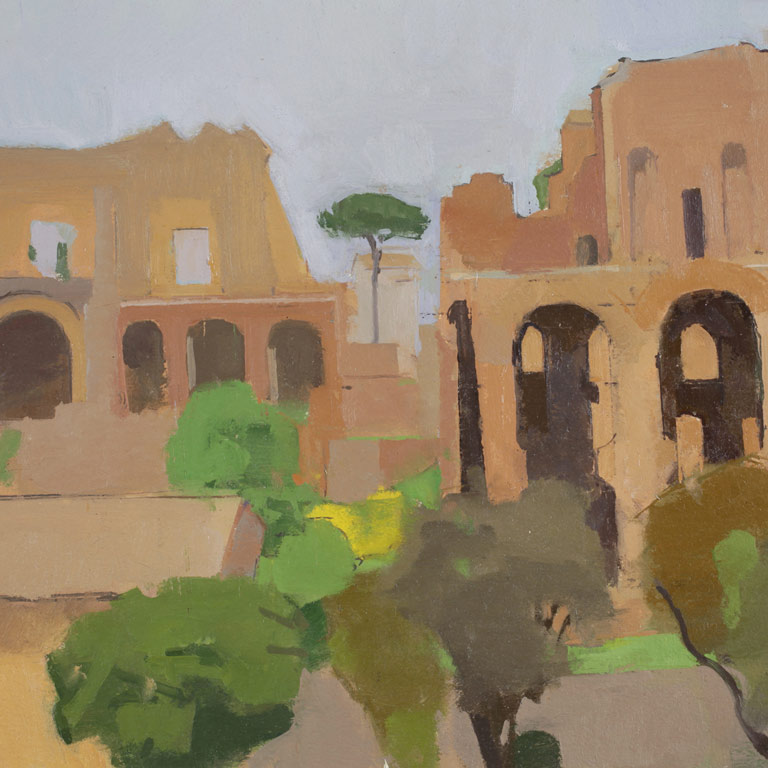Exhibition: October 14–December 3, 2021
Opening Reception: Thursday, October 14 from 6–8 PM
The Indiana University J. Irwin Miller Architecture Program presents Tale of Two Cities/ Rome, Berlin by artists and IU faculty members Eve Mansdorf and Tim Kennedy in the gallery at The Republic Building (333 2nd Street, Columbus, IN 47201).
"During the summers of 2018 and 2019 Eve Mansdorf and I traveled to Europe to paint on site in the cities of Berlin and Rome. We carried French easels in our luggage and painted in oil on a paper manufactured by the French paper mill Arches. I also did some watercolors. Working on paper was a practical solution to the problem of bringing the work back to the United States after our journey. None of the paintings was very large – in almost all cases they measured under 12 by 16 inches.
Working on site presents challenges to the artist, although we are old hands at this now and sometimes forget that it is a discipline that not everyone is familiar with. With all of the hardware and tools we carry – easels, paints, brushes, paper towels, solvent, drinking water – and wearing work clothes we resemble laborers – or even pack animals. We traveled to our motifs by public transportation, at times over an hour in each direction. Each work evolved in two or three hour (sometimes longer) work sessions and each painting consisted of two or three of these sessions. We worked in all types of weather – sometimes cold and rainy and sometimes extremely hot. Of necessity, we had to be somewhat oblivious of our surroundings. At times our activity attracted the attention of passersby. Occasionally we engaged in conversation with these spectators and sometimes we were forced to ignore them.
In Germany our sites were the Tiergarten in Berlin and Sanssouci in Potsdam. The Tiergarten is a huge, heavily wooded park studded with shallow, stagnant lakes favored by boaters and the occasional bronze sculpture. It had been the hunting preserve of Fredrick the Great during the 18th century. Looking at it now, it is hard to believe that at the close of the Second World War it was completely denuded of trees by the citizens of Berlin in search of firewood. The subjects we favored were sycamores on the shores of the lake and sculptural groups depicting hunters.
Potsdam is a town on the outskirts of Berlin and the home to Sanssouci, Fredrick the Great’s formal garden modeled after Versailles. Sanssouci is French for “without worries” and was Fredrick the Great’s refuge from court life in Berlin. Circuitous garden paths radiate out from a central fountain encircled by the mythologically inspired sculptures of the French Rococo artist Pigalle. Yet the park itself is very German, employing groundskeepers that apply insanely precise methods of hedge trimming with military discipline. The garden is a veritable World’s Fair or an 18th century theme park with many sculptural groups. There is a Roman Bath and a Sicilian Garden. We spent time painting around a group of allegorical figures representing music and then moved on to representations of the seasons. The haunted quality of the sculptural groups was part of their appeal.
We spent most of our time in Sanssouci at a Rococo structure known as the Chinese House, done in Chinoiserie style, the slightly less dark cousin of Orientalism. Think of Chippendale furniture. The building is clearly a fantasy by Europeans that had never visited China but wanted to create some Elysian place they imagined from things that were familiar to them. Chinese tourists seemed to react to it with a mixture of puzzlement and might even have been slightly flattered. Western tourists, particularly Americans, seemed horrified at the cultural stereotypes it perpetuates. A round carousel like structure, the porticoes of the building are supported by columns based on an invented order of architecture imitating the bark of palm trees and blossoming into an intricate maze of fronds at the capital. The thing that attracted us as painters were the groups of gilded sandstone sculpted figures engaged in activities such as tea drinking on the porches, none of the models looking very Asian. The temptation to paint the figures arose from their marvelous reflective quality. One day while we were working a passerby asked us, “What color are the sculptures?”. We responded by simply saying that they had no inherent color but were constantly being influenced by their surroundings, changes in light and the weather.
In Rome we were very aware of walking in the footsteps of Piranesi and Corot while we painted many of the same subjects including the Colosseum, the Palatine hill, the Ponte Rotto and Tiber Island, Castel Sant’Angelo and the Roman Forum. A constant consciousness of the palpable presence of time is the reality of life in Rome. Layers of history are evident everywhere. We learned about the monuments as we painted them. Italy’s climate can be harsh; we encountered rain and cold in May followed by intense heat and sun in June. But in all cases Roman light, particularly toward the end of the day, is magical."
Tim Kennedy
Eve Mansdorf Bio
Eve Mansdorf received her MFA in Painting from from Brooklyn College and her BA in Psychology from Cornell University. She teaches Painting at Indiana University in Bloomington, Indiana. She is known for large paintings of figures in interiors, still lifes and on site paintings that draw from the landscape and the neighborhood in Bloomington where she lives.
Eve Mansdorf paints perceptually and often her work is done close to home – even when her “home” relocates to other countries and parts of the US. The group of paintings in this exhibition were done while living in Berlin and Rome. She has shown her work at First Street Gallery and Gallery Henoch in New York and at various venues in the Midwest.
Tim Kennedy Bio
Tim Kennedy received his BFA from Carnegie Mellon University, an MFA from Brooklyn College and he attended the Skowhegan School. Kennedy has received individual artist grants from the Pollock-Krasner Foundation, the Indiana Arts Commission, the Arts Council of Indianapolis and the Clark Hulings Fund. His work has been reviewed in The New York Sun, The New York Observer and the Indianapolis Star. Articles on his work have appeared in The Artist’s Magazine, American Artist Magazine and Watercolor Magazine. An interview with Tim Kennedy was featured on Larry Groff’s blog Painting Perceptions. He exhibits his work at First Street Gallery in New York and is a Senior Lecturer of Painting at Indiana University in Bloomington.
Kennedy’s work embraces all of the genres but he has repeatedly returned to themes of domestic interior and landscape. He works primarily from observation and directly from the motif or from painted or drawn studies done directly from the subject. His goal is to work directly and without an intervening filter.
The gallery is open Monday through Friday from 9:00 am - 5:00 pm.



